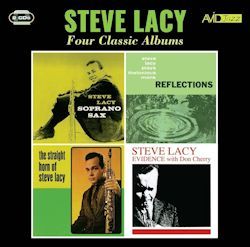CD1
Soprano Sax
1. Day Dream
2. Alone Together
3. Work
4. Rockin' In Rhythm
5. Little Girl Your Daddy Is Calling You
6. Easy To Love
Reflections – Steve Lacy Plays Thelonious Monk
7. Four In One
8. Reflections
9. Hornin' In
10. Bye-Ya
11. Let's Call This
12. Ask Me Now
13. Skippy
CD2
The Straight Horn Of Steve Lacy
1. Louise
2. Introspection
3. Donna Lee
4. Played Twice
5. Air
6. Criss Cross
Evidence - Steve Lacy with Don Cherry
7. The Mystery Song
8. Evidence
9. Let's Cool One
10. San Francisco Holiday
11. Something To Live For
12. Who Knows
Steve Lacy’s evolution from Bechet acolyte to post-Rollins improviser came in a truncated period of time and the earliest LP here, called simply Soprano Sax, catches him well on his Modernist road. Teamed with Wynton Kelly, Buell Neidlinger and Dennis Charles this 1957 date, recorded in
Rudy Van Gelder’s NJ studio showcases that oft-astringent, oboe-like tone with its sinuous typically eloquent lyric lines; a sound quite unlike any other
and by now wholly different – could not be more different – from the fat vibrato and opulently operatic tone produced by Bechet. The angularity of his
phrasing, his predilection for Monk and a curious liking for Calypsos – shared by Kelly who was Jamaican - are part of the success of this date.
The absorption of Monk’s message can be savoured to the full in Reflections, in which all the seven tracks are Monk’s. Neidlinger is retained, but
Mal Waldron replaces Kelly and the drummer is now the more powerful and virtuosic Elvin Jones. This is something of a curious date. Waldron is so
solicitous to Monkish procedure that he often sits out of the ensemble, whilst Jones is over-busy. Lacy’s tone takes on an occasionally acrid quality. It’s
only Skippy that truly convinces, where the rhythmic allusions and the rhythmic caprices are held in fine accord and where Jones calms down
sufficiently to prove supportive. Only the under-recorded bass disappoints.
Half the tracks on The Straight Horn of Steve Lacy are again by Monk. Charles Davis, the baritone sax player, partners Lacy in the front line with
John Ore the bassist and Roy Haynes (much better than Elvin Jones) the drummer. The gruff baritone proves an intriguing sonic foil for the acidic Lacy as
the instruments revel in piano-less freedom. Their trades are well practiced. For all the pleasures of this date there remains something just a little
hokey about that front line ensemble sound. The final LP sees Lacy teamed with a musician of a similar stripe, Don Cherry, in another piano-less quartet.
There’s a lot of ‘space’ in the playing and Lacy’s tone is more focused here – possibly the Van Gelder studio ironed out the problems inherent in the
earlier recording as Lacy seems to have had problems being well recorded. The tunes are by Monk (4) and Ellington (2) and here one feels that the
Lacy-Cherry front line is an apt one, assured technically and timbrally, with two musicians who understand the history and grammar of everything they play
– not least the two less-well known Ducal offerings. This is the most accomplished and convincing date of the four.
Lacy followers will be reassured to know that all the LPs are heard intact, that the liner notes are reprinted verbatim – but with no added information –
and full personnel details are present and correct. Good transfers too.
Jonathan Woolf
